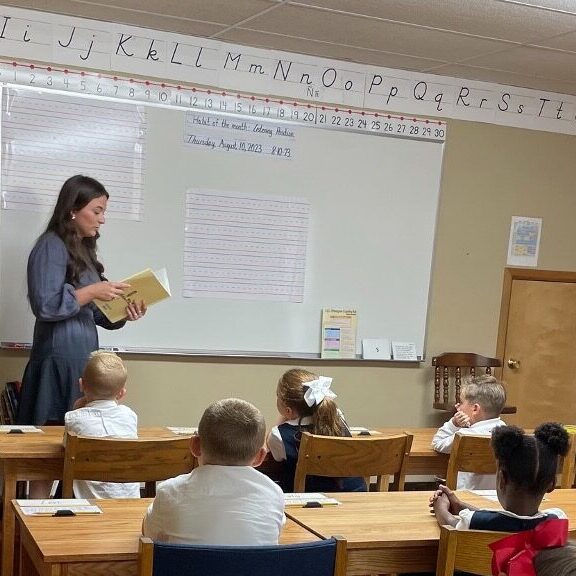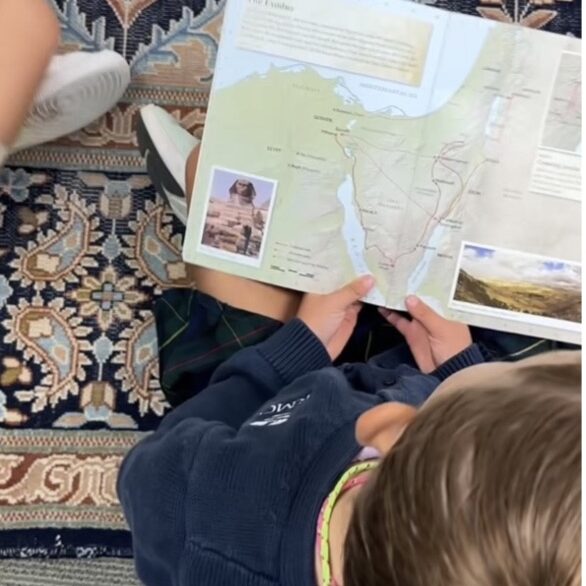Ambleside Schools International Articles

Image courtesy of Ambleside School of Boerne.
Browse more Ambleside Schools International Resources.
Video Series Part 13. Chapter Ten: What is a Habit?
“Habits are to life as rails are to a train.”
Habit is a propensity to respond to a given situation in a certain way without having to think about it. When a habit is formed, a change takes place in the brain; neurons that fire together wire together (Hebb’s Law). By intentionally and carefully forming new habits in children, we can “lift them above their natures,” freeing them from negative propensities. Focused attention is the most important educational habit to be formed because that to which we give attention, we come to know.
In Part 13 of our video and discussion guides, Bill St. Cyr gives insight to the formation of habits. Charlotte Mason understood that when a habit is formed there is a physical change in the brain. Every time we learn something new, a new neural network is laid down. The more you repeat an activity, the more frequently and easily these neurons fire together. And neurons that fire together wire together —the neurological basis for the formation of a habit. The key is we can form new (better) habits!
The Laying Down Of Lines of Habit1
‘Begin it, and the thing will be completed!’ is infallibly true of every mental and moral habitude: completed, not on the lines you foresee and intend, but on the lines appropriate and necessary to that particular habitude.’
Habit rules ninety-nine in a hundred of our Thoughts and Acts. In the first place, whether you choose or no to take any trouble about the formation of his habits, it is habit, all the same, which will govern ninety-nine one-hundredths of the child’s life: he is the mere automaton you describe. As for the child’s becoming the creature of habit, that is not left with the parent to determine. We are all mere creatures of habit. We think our accustomed thoughts, make our usual small talk, go through the trivial round, the common task, without any self-determining effort of will at all. If it were not so –– if we had to think, to deliberate, about each operation of the bath or the table –– life would not be worth having; the perpetually repeated effort of decision would wear us out. But, let us be thankful, life is not thus laborious. For a hundred times we act or think, it is not necessary to choose, to will, say, more than once. And the little emergencies, which compel an act of will, will fall in the children’s lives just about as frequently as in our own. These we cannot save them from, nor is it desirable that we should. What we can do for them is to secure that they have habits which shall lead them in ways of order, propriety, and virtue, instead of leaving their wheel of life to make ugly ruts in miry places.
Habit powerful even where the Will decides. And then, even in emergencies, in every sudden difficulty and temptation that requires an act of will, why, conduct is still apt to run on the lines of the familiar habit. The boy who has been accustomed to find both profit and pleasure in his books does not fall easily into idle ways because he is attracted by an idle schoolfellow. The girl who has been carefully trained to speak the exact truth simply does not think of a lie as a ready means of getting out of a scrape, coward as she may be.
But this doctrine of habit, is it, after all, any more than an empirical treatment of the child’s symptoms? Why should the doing of an act or the thinking of a thought, say, a score of times in unbroken succession, have any tendency to make the doing of that act or the thinking of that thought a part of the child’s nature? We may accept the doctrine as an act of faith resting on experience; but if we could discover the raison d’être of this enormous force of habit it would be possible to go to work on the laying down of habits with real purpose and method.
The Physiology Of Habit. A work of Dr. Carpenter’s was perhaps the first which gave me the clue I was in search of. In his Mental Physiology –– a most interesting book, by the way –– he works out the analogy between mental and physical activity, and shows that the correspondence in effect is due to a correspondence in cause.
Growing Tissues form themselves to Modes of Action. To state roughly the doctrine of the school Dr Carpenter represents –– the tissues, as muscular tissue, for instance, undergo constant waste and as constant reparation. Even those modes of muscular action which we regard as natural to us, as walking and standing erect, are in reality the results of a laborious education; quite as much so as many modes of action which we consciously acquire, as writing or dancing; but the acquired modes become perfectly easy and natural. Why? Because it is the law of the constantly growing tissues that they should form themselves according to the modes of action required of them. In a case where the brain is repeatedly sending down to the muscles, under nervous control as they are, the message to have a certain action done, that action becomes automatic in the lower centre, and the faintest suggestion from outside comes to produce it without the intervention of the brain. Thus, the joints and muscles of the child’s hand very soon accommodate themselves to the mode of action required of them in holding and guiding the pen. Observe, it is not that the child learns with his mind how to use his pen, in spite of his muscles; but that the newly growing muscles themselves take form according to the action required of them. And here is the explanation of all the mountebank feats which appear simply impossible to the untrained looker-on. They are impossible to him, because his joints and muscles have not the same powers which have been produced in the mountebank by a process of early training.
Questions and Thoughts to Consider:
- How did Charlotte Mason’s ideas about habit anticipate those of modern neuroscience?
- What is the effect on a child of forming new habits?
- How do we lift children above their nature?
- What is Hebb’s law? How does it relate to habits?
- Explain how the power of attention is a habit.
1 Charlotte Mason, Home Education, 107-112.



